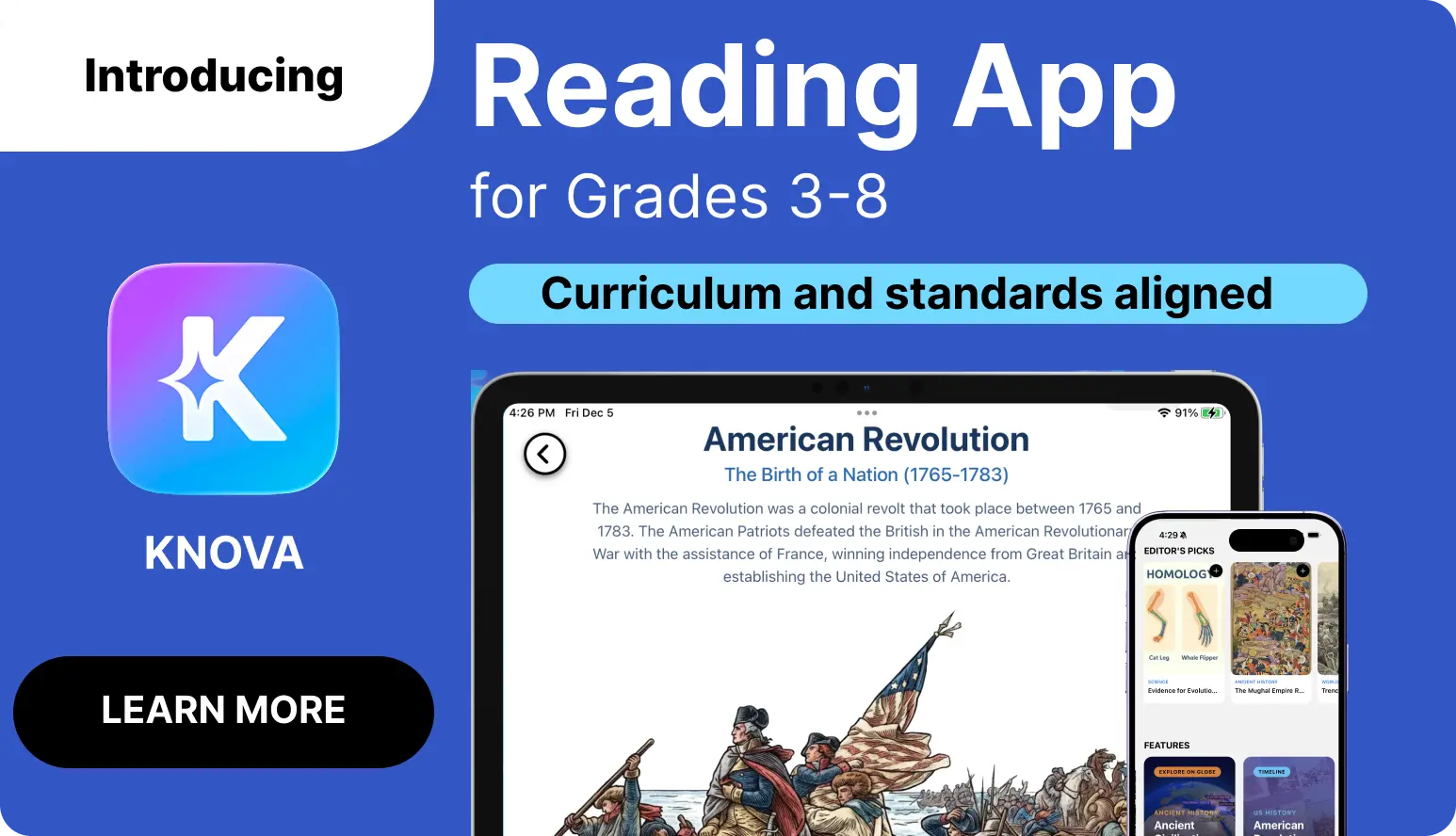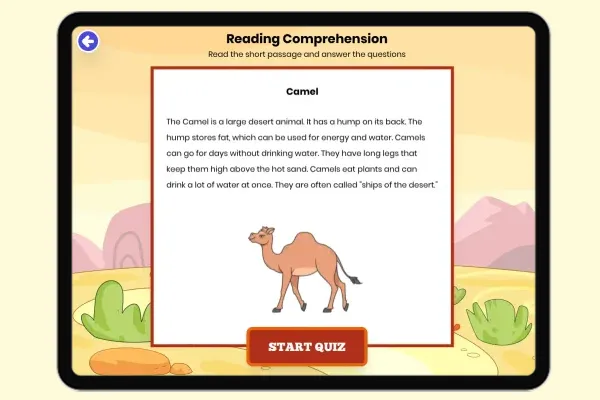Reading Results
The States of Matter: Solid
Discover the differences between solids, liquids and gases by exploring how their particles are arranged and move. This ...
RI.4.2RI.4.3RI.4.4RI.5.1
What is a Simple Machine
Discover the power of simple machines! This informational text explores how basic tools like levers, pulleys and incline...
RI.4.2RI.4.3RI.4.4RI.5.1
Main causes of a heat dome?
Heat domes are caused by specific atmospheric patterns, primarily involving high-pressure systems. These high-pressure a...
RI.5.1
Health Risks of Heat Domes
Heat domes pose significant health risks as our bodies struggle to maintain a safe temperature in extreme heat. Dehydrat...
RI.5.1
Heroes for Freedom: Frederick Douglass
Frederick Douglass overcame slavery to become a leader in the fight for freedom and civil rights. His powerful speeches ...
RI.3.1RI.4.4RI.4.2RI.5.2
Natural Disaster: Tornadoes
Tornadoes are dangerous spinning columns of air. Knowing the signs and having safety plans can help protect you from the...
RI.3.1RI.4.4RI.4.2RI.5.2
Natural Disaster: Hurricanes
Hurricanes are massive storms with strong winds and rain. Tracking and preparing for them helps protect people in their ...
RI.3.1RI.4.4RI.4.2RI.5.2
Natural Disaster: Droughts
Droughts are long periods with insufficient water, leading to crop failures and water shortages. Conserving water and pl...
RI.3.1RI.4.4RI.4.2RI.5.2
Bats in the Night
This informative first-grade reading passage delves into the intriguing world of bats, highlighting their nocturnal natu...
RI.3.1RI.4.4RI.4.3
Camel
The Camel is a large desert animal easily recognized by the hump on its back, which stores fat that can be converted to ...
RI.3.1RI.4.4RI.4.4
Desert Bighorn Sheep
The Desert Bighorn Sheep is a remarkable desert animal known for its strength and agility. These sheep have strong legs ...
RI.3.1RI.4.4RI.4.7
Desert Jerboa
The Desert Jerboa is a small rodent that thrives in the desert environment. It has long back legs that enable it to jump...
RI.3.1RI.4.4RI.4.10
Rattlesnake
The Rattlesnake is a venomous snake that thrives in desert environments. It is easily recognized by the rattle at the en...
RI.2.1RI.3.1
What Turtles Eat?
Turtles exhibit a wide range of dietary preferences, reflecting their diverse habitats and evolutionary adaptations. Her...
RI.1.2RI.1.1
Turtle Conservation
Turtle conservation has become an increasingly critical issue as many species face numerous threats in both aquatic and ...
RI.2.1RI.3.6
Starfish Shapes and Colors
Starfish, or sea stars, display an incredible diversity of shapes and colors that fascinate marine enthusiasts and young...
RI.1.1RI.1.2RI.1.8
Starfish Body Parts
Starfish, or sea stars, possess a remarkable anatomy that enables them to thrive in diverse marine environments. The bod...
RI.1.1RI.1.2RI.1.8
Types of Coral: Hard and Soft
This passage delves into the two primary types of coral: hard and soft coral. First-grade readers are introduced to the ...
RI.1.1RI.1.2RI.1.10
Coral Habitats: Where the Ocean Comes Alive
This passage introduces first-graders to the specific habitats where coral thrives. It explains that coral requires warm...
RI.1.1RI.1.2RI.1.11
Why the Great Barrier Reef Matters
This passage highlights the critical importance of the Great Barrier Reef for both nature and humans. It emphasizes the ...
RI.3.1RI.4.1
What is Weather?
This passage explains weather to children, describing it as the current outdoor conditions. It covers various weather ty...
RI.3.1RI.4.14.ESS2.D
What is the Greenhouse Effect?
This passage introduces the greenhouse effect to children, comparing it to a blanket around Earth. It explains how sunli...
RI.3.1RI.4.14.ESS2.D
Can you give an example of a renewable energy source?
This passage focuses on solar energy as an example of renewable energy for children. It explains how solar panels captur...
RI.3.1RI.4.14.4-ESS3
Reduce Your Carbon Footprint: Simple Tips for Home
This passage focuses on reducing carbon footprints at home by conserving electricity. It suggests practical actions like...
RI.3.1RI.4.14.ESS2.D4-ESS3
How Kids Can Help Fight Climate Change?
This passage introduces the concept of 'reduce, reuse, recycle' as a way for children to help fight climate change. It e...
RI.3.1RI.4.14.ESS2.D4-ESS3
Cesar Chavez: A Voice for Farm Workers
This reading passage introduces elementary students to Cesar Chavez and his work advocating for farm workers' rights. Th...
Precipitation: Types and Measurement
Precipitation includes rain, snow, sleet, and hail, forming when water droplets in clouds grow large enough to fall. It ...
7.RI.7.3
Air Masses: Types and Characteristics
Air masses are large bodies of air with similar temperature and humidity. They form over specific regions and influence ...
7.RI.7.1
Weather Fronts: Types and Impacts
Weather fronts are boundaries between air masses that bring weather changes like precipitation and storms. Types include...
7.RI.7.3
Cyclones and Anticyclones: A Comparison
Cyclones are low-pressure systems that bring stormy weather, while anticyclones are high-pressure systems that bring cle...
7.RI.7.1RI.5.3RI.5.5RI.6.9
Cold Fronts and Warm Fronts: A Comparison
Cold fronts bring thunderstorms and cooler temperatures, while warm fronts bring light rain and warmer temperatures. Bot...
7.RI.7.3RI.5.3RI.5.5RI.6.9
Latitude: A Key Factor Affecting Climate
Latitude determines a region’s climate by affecting sunlight and temperature. Tropical regions near the equator are warm...
RI.5.3
Large Bodies of Water: A Key Factor Affecting Climate
Large bodies of water moderate temperatures, making coastal regions milder. They also contribute to humidity and precipi...
RI.5.5
Elevation: A Key Factor Affecting Climate
Elevation influences climate by causing temperatures to drop as altitude increases. High-elevation areas receive more so...
RI.5.3
Mountain Ranges: A Key Factor Affecting Climate
Mountain ranges affect climate by creating rain shadows, blocking wind, and forming microclimates. They play a key role ...
RI.5.5
Vegetation: A Key Factor Affecting Climate
Vegetation influences climate by cooling temperatures, increasing humidity, and supporting rainfall. Forests also preven...
RI.5.3
Hydrosphere: What Is It and Its Formation
The hydrosphere includes all water on Earth, from oceans to glaciers. It formed through condensation and precipitation a...
RI.5.5
Porosity and Permeability of Soil and Rock
Porosity and permeability are key properties of soil and rock that affect water movement underground. They influence gro...
RI.5.5RI.6.9
Stream Flow
Stream flow refers to the movement of water in rivers and creeks. It is influenced by precipitation, slope, and human ac...
RI.5.5RI.6.9
The Mississippi River
The Mississippi River is one of the longest rivers in North America, stretching 2,340 miles from Lake Itasca to the Gulf...
RI.5.3RI.6.3RI.7.3
How Can We Help Pollinators and Stop Their Decline?
Pollinators including bees (Apis mellifera), butterflies (Lepidoptera), birds, and bats face severe threats with 40% of ...
MS-LS2-4RI.7.3RI.8.8RI.8.3
Saving Snow Leopards
Snow leopards face many threats today. People are building roads and farms in their mountain homes. Some hunt them for f...
MS-ESS3.CRI.6.7RI.7.8RI.8.9
Intrusive Igneous Rocks: Formation and Features
This passage explains the formation of intrusive igneous rocks through slow cooling of magma beneath Earth's surface. It...
MS-ESS2-3RI.6.1RI.7.4RI.8.2
Stratigraphy: Reading Earth's Layered History
This passage explains stratigraphy as the study of rock layers to interpret Earth's history. Aligned with NGSS MS-ESS1-4...
MS-ESS2-1MS-PS1-2RST.6-8.3
Do Protons and Electrons Have the Same Mass?
This reading passage, 'Do Protons and Electrons Have the Same Mass?', helps middle school students explore the massive d...
MS-PS1HS-PS1RI.6.3RI.7.1
How Many Neutrons Does Hydrogen Have?
This reading passage, 'How Many Neutrons Does Hydrogen Have?', introduces middle school students to atomic structure usi...
MS-PS1HS-PS1RI.6.3RI.7.1
Understanding Specific Heat
This passage, 'Understanding Specific Heat,' explains the concept of specific heat to middle school students in an acces...
MS-PS3HS-PS3RI.6.3RI.7.1





















































